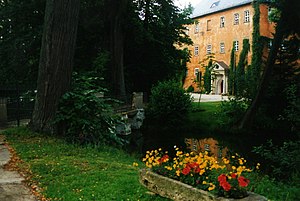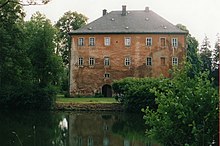Weissdorf moated castle
| Weissdorf moated castle | ||
|---|---|---|
|
Front view of the moated castle Weißdorf with moat and entrance portal |
||
| Alternative name (s): | Weißdorf Castle | |
| Creation time : | 1364 | |
| Conservation status: | After the destruction in 1523 a new castle was built on the foundation walls | |
| Standing position : | Knighthood | |
| Construction: | Nothing special | |
| Place: | Weissdorf | |
| Geographical location | 50 ° 11 '12 " N , 11 ° 50' 51.3" E | |
|
|
||
The moated castle Weißdorf , also called Burg Weißdorf , is a moated castle in Weißdorf , a municipality in the district of Hof in Upper Franconia . The knight's seat was founded by the von Sparneck family and belonged to the family's ancestral territory for centuries.
Founding and rule of the Sparnecker
The castle complex was first mentioned in a document on July 13, 1364. It was owned by the von Sparneck family, who for centuries ruled over an area that roughly corresponded to the former Münchberg district . An important member of the family was Hans II. Of Sparneck as steward and marshal of the Burgrave Frederick V of Nuremberg and bailiff in Hof (Saale) . He subordinated the allodial property in Weißdorf to the burgrave and received it back as a fief . His son Hans III. von Sparneck was a knight and bailiff of Münchberg . Around 1430 the Hussites attacked the knight's seat. In the 16th century the influence of gender declined. Sebastian von Sparneck appeared as a robber baron and assistant to Hans Thomas von Absberg , which in 1523 led to the destruction of the castle by the Swabian Federation .
The fateful year 1523
Before the federal army set out to destroy a total of 23 “predatory nests” (five of which were in the possession of the Sparnecker), the aides of the Absberger were given the chance to renounce complicity by taking an oath . This process began on April 26, 1523 and is known as the Bundestag zu Nördlingen . Some of the nobles took this oath, but most of them either never came or, like the Sparnecker, were not admitted to the oath.
On June 16, the Federal Army, which supposedly consisted of 10,000 foot soldiers and 1,000 horsemen, carrying 100 cannons and 40 rifles, set in motion. This army was given the task of "tearing up, burning and dismantling" a total of 23 castles belonging to the Absberger's helpers. In addition to Weißdorf, these included the castles in Gattendorf , Sparneck on the Waldstein and the Uprode near Münchberg . On Wednesday, July 8th, 1523, the armed forces arrived in the Sparneck area. While the proud fortresses Sparneck, Waldstein and Uprode collapsed in fire, the fate of the castle in Weißdorf was also fulfilled.
When the troops wanted to blow up what they believed to be the abandoned castle, they found Sebastian von Sparneck's wife, in labor, in childbirth . She probably believed that by staying she could stop the destruction of the home. The field leader left some of the hook rifle shooters in the castle and ordered them to blow it up after the child was born. However, the woman left her child bed beforehand with the words: "If it has to be, I don't want to stop it." Then on July 12, 1523 the castle in Weißdorf was blown up.
War correspondent Hans Wandereisen , who made woodcuts of the burning castles, went with the federal army . He also painted the valley fortress Weißdorf when it went down. The heavily fortified complex, which consisted of a main house and a strong surrounding wall , is shown as being surrounded by a moat and secured by a picket fence . A drawbridge led across the moat to the main gate, which was guarded from a gatehouse . The houses and the church of St. Maria with its striking tower are grouped around the castle .
The further structural development to the castle
The moated castle in Weißdorf was the only property of the Sparnecker family, which was rebuilt after the federal campaign in 1543. The original fortified complex lost its defensive character and is now a small baroque country palace. In 1606 the castle was renovated and an additional floor was added. In 1775 the inner ditch was filled and in 1875 the circular wall and tower were demolished. In 1853 it was bought by the royal Saxon councilor Louis Leuckart from Dresden. The family was raised to the hereditary baron status of the Kingdom of Bavaria in 1879 and has been called Leuckart von Weißdorf since then . The castle is still owned by the family; Visits are not possible.
literature
- Peter Braun: The gentlemen from Sparneck. Family tree, distribution, brief inventory. ( Archive for the history of Upper Franconia. Volume 82). 2002, pp. 71-106.
- Tilmann Breuer : District of Münchberg . ( The art monuments of Bavaria . Brief inventories, Volume XIII). Deutscher Kunstverlag , Munich 1961, pp. 59–61.
- Karl Dietel : AD 1523 The Weißdorf Palace is destroyed. In: Leaves from the Fichtel Mountains.
- Reinhardt Schmalz: The Franconian War and the guilt of the Sparnecker. In: Archives for the history of Upper Franconia. Volume 85, 2005, pp. 151-160.
- Karl Dietel's records in the Münchberg City Archives





